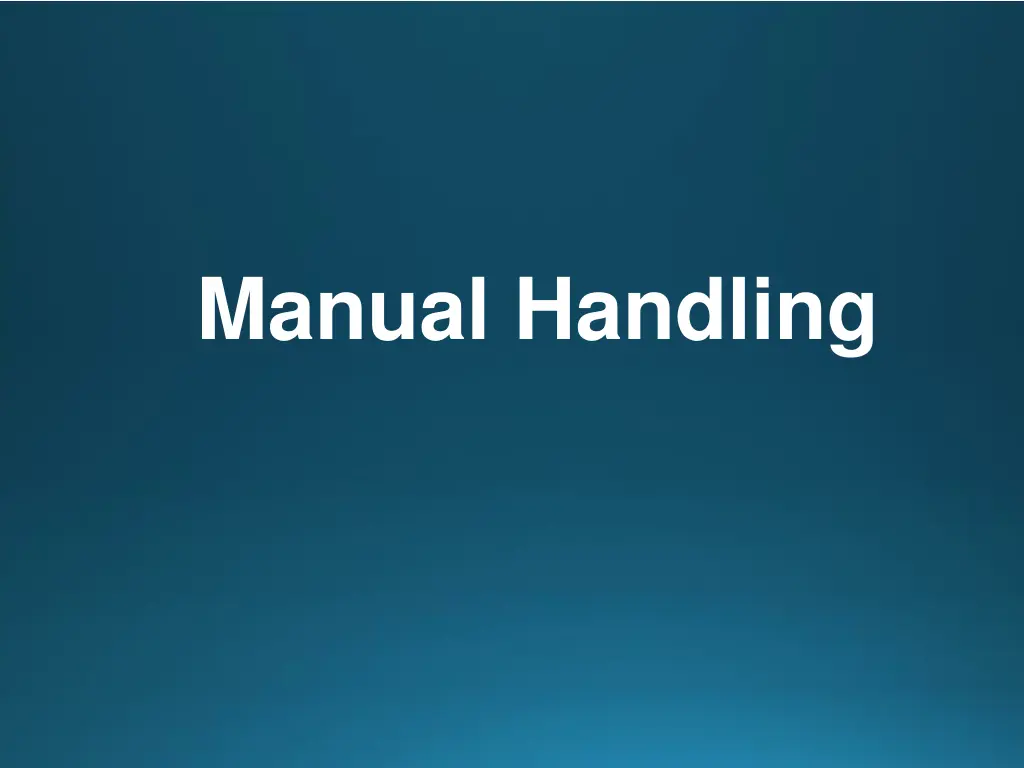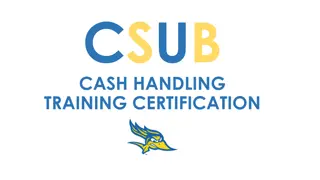
Understanding Manual Handling in the Workplace
Learn about manual handling, its definition, accident statistics, mechanics involved, regulations, risk assessment, and important considerations for employers and employees. Proper manual handling practices are crucial for preventing workplace injuries and ensuring a safe working environment.
Download Presentation

Please find below an Image/Link to download the presentation.
The content on the website is provided AS IS for your information and personal use only. It may not be sold, licensed, or shared on other websites without obtaining consent from the author. If you encounter any issues during the download, it is possible that the publisher has removed the file from their server.
You are allowed to download the files provided on this website for personal or commercial use, subject to the condition that they are used lawfully. All files are the property of their respective owners.
The content on the website is provided AS IS for your information and personal use only. It may not be sold, licensed, or shared on other websites without obtaining consent from the author.
E N D
Presentation Transcript
Definition of Manual Handling The transporting or supporting of a load by hand or some other part of the body including the lifting, putting down, pushing, pulling, carrying, moving or intentionally dropping or throwing a load
Accident Statistics Largest cause of accidents at work 37% Manual Handling 19% Slips, Trips and Falls 12% Other Causes 20% Struck by an Object 7% Falling from Height 5% Machinery
Mechanics Balance point is through centre of body when standing A load held in front disturbs the balance - tension is generated in the back muscles to compensate Forms a lever effect Average person holding a 10kg load at arms length generates a counterbalancing tension up to 10 times more to avoid falling over High or repetitive levels of tension in the back can cause damage called muscle strain
Mechanics Centre of Gravity Centre of Gravity Lever effect is reduced if load held closer to the body
Manual Handling Regulations 1992 Regulations provide a hierarchy of measures Employers must: Avoid manual handling where possible Assess any hazardous activities where manual handling can t be avoided If the assessment indicates a significant risk of injury a more specific assessment must be made Reduce the risk of injury as far as is reasonably practicable
Manual Handling Regulations 1992 Employees have duties: Follow the laid down systems of work Make proper use of equipment provided Co-operate in H&S matters Advise your manager if you are unwell Not putting other people at risk
Risk Assessment T Task I Individual s capabilities L Load E Environment any other factors
The Task Strenuous pushing and pulling Holding loads away from body Twisting Stooping Reaching upwards Large vertical movements Long travel distances Unpredictable movement of load Repetitive handling Insufficient rest or recovery time Work rate imposed by the process
Individual Capability Physical condition Illness Pregnancy Requires unusual capabilities Call for special information or training
The Load Heavy Bulky or unwieldy Difficult to grasp Unstable/unpredictable Harmful ie sharp/hot
The Working Environment Constraints on posture eglack of space Poor flooring Variations in levels Hot/cold/rain/ice/humid conditions Strong air movement Poor lighting conditions
Other Factors Is movement hindered by clothing or personal protective clothing and people!! High Stress Poor Diet Lack of exercise Rushing pressure of work Short cuts
Risk Assessment Summary Identify the elements of significant risk Decide who might be harmed and how Evaluate risks/Control measures Record the findings of assessment Review/revise assessment T I L E Task Individual s capabilities Load Environment
Lifting Safely Ultimate Objective: To Relieve Fatigue & Strain Use correct handling techniques Ensure good vision Change position regularly Avoid over reaching or stretching Adjust work surface heights Relax where possible Use mechanical aids
Kinetic Lifting Summarised by: Plan the Route Assess the load Correct position of feet Straight back Correct grip Lift smoothly
Kinetic Lifting Plan the Route Where is the load going Are there obstructions in the way Is there somewhere to set it down
Kinetic Lifting One Person Lift Determine the weight Look for sharp edges See if weight is evenly distributed Keep heaviest side to body Decide how to hold the load If it is too heavy use a trolley or get assistance
Kinetic Lifting Correct Positioning of Feet Comfortably apart One foot positioned in direction of movement Other foot where it can give maximum thrust to the body To maintain good balance feet should never be too close together on the ground
Kinetic Lifting Straight Back Lower the body by relaxing the knees Keep your back straight (but not vertical) Keep load close to body Keep chin in and head back
Kinetic Lifting Lifting If lifting from ground make maximum use of legs Keep back straight but inclined forward As lift proceeds and the legs are straightened the back returns to vertical position Positioning of feet and bending of knees are the key factors in maintaining a straight back
Kinetic Lifting Correct Grip Take a firm grip by using the palms of the hands and roots of fingers Taking weight on finger tips will create pressure at the end of fingers and could strain muscles and tendons in the arms A full palm grip will reduce muscle stress to the arms and decrease the possibility of the load slipping
Kinetic Lifting Lifting Smoothly Thrust from back foot and straightening of knees will move body forwards and upwards briefly off balance Immediately countered by bringing the back foot forward as if walking Lift now completed -forward movement results in smooth transition from lifting to carrying
Kinetic Lifting Carrying the Load Make sure you can see where you are going Avoid twisting the body move your feet instead If you need to change your grip set the load down not whilst walking Setting the Load Down Use the correct stance for lifting and set the load down gently
Kinetic Lifting Two Person Lift Decide who will be caller Assess the weight Correct positioning of feet Straight back Correct grip Lift together The caller co-ordinates the lift and ensures each lifter knows what to do and when
Kinetic Lifting Summary Plan the route, the lift and the set down point Position your feet - bent knees, straight back Firm grip, lift smoothly, Move the feet do not twist body Keep the load close to the body Put down smoothly then adjust for final position






















